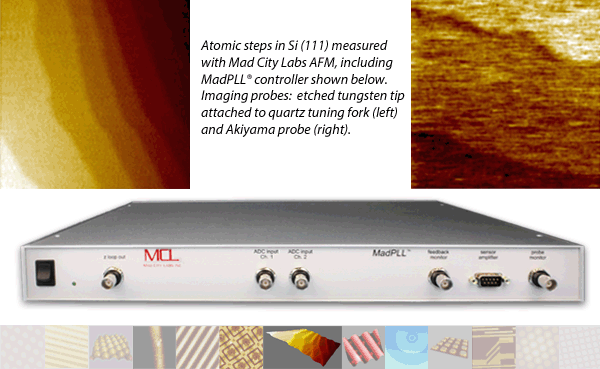 What is MadPLL®? What is MadPLL®?
MadPLL® is an integrated solution that includes the digital phase lock loop (PLL) controller, software, sensor amplifier, probe board mount, and resonant probe mounting board. Simply add your Akiyama probe or tuning fork to the probe board to create a powerful force sensor for scanning probe measurements.
The MadPLL® package includes the MadPLL® digital PLL controller, sensor board, probe board, and MadPLL® software. Ease of integration with resonant probes and Mad City Labs' low noise nanopositioning systems give users the ability to create high performance, low cost NSOM and AFM instruments.
The PLL controller contains a digitally controlled proportional integral (PI) loop designed to work seamlessly with Mad City Labs’ nanopositioning systems. The addition of closed loop nanopositioners adds to the high performance of MadPLL®. Additional options are available for multi-axis closed loop nanopositioning control.
The PLL controller has three operational modes: self oscillation, PLL driven, and (lock-in) DDS driven. The probe can be controlled in constant excitation or constant signal mode. Measured outputs from the controller include changes in frequency, amplitude or phase shift.
The digital MadPLL® controller has three operational modes: self oscillation, PLL driven, and DDS driven. The probe can be controlled in constant excitation amplitude or constant signal amplitude. Changes in frequency, amplitude, or phase are measured for Z control.
The sensor amplifier is the interface between the MadPLL® controller and the probe. The sensor amplifier contains a preamplifier, an excitation signal attenuator, and a parasistic capacitance compensation (PCC) circuit. The probe board mount and probe board assemblies are compact and can be fitted to existing instrumentation. The probe board simply plugs into the probe board mount. The mount can be fixed to a precision positioner such as a closed loop nanopositioning system. The probe board has been designed for use with tuning forks and Akiyama probes. These probes are easy to mount and alignment free.
MadPLL® includes a sensor amplifier, probe boards, and intermediate probe mount. The probe boards are designed for use with tuning forks, Akiyama probes and Accutune probes.
|













